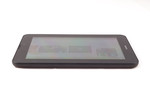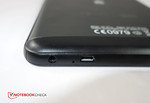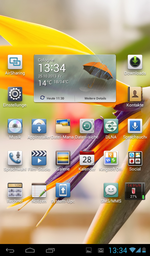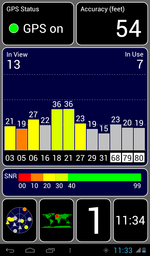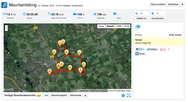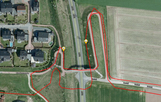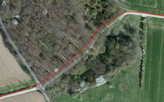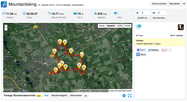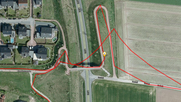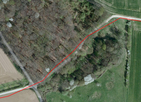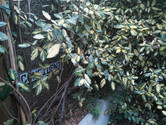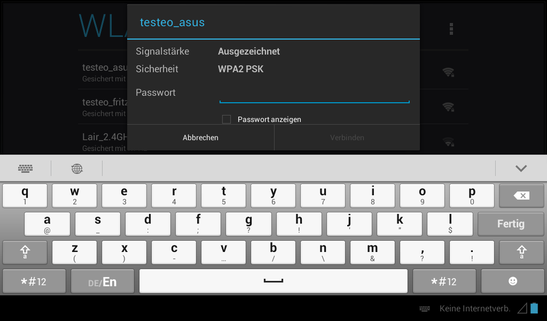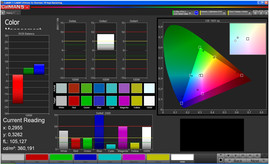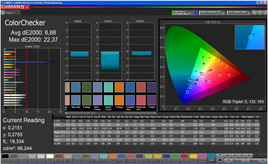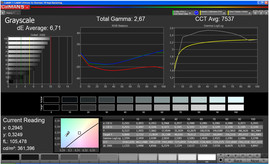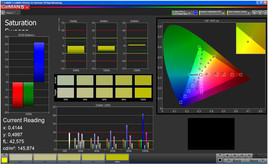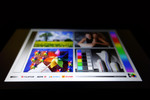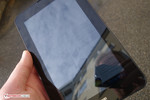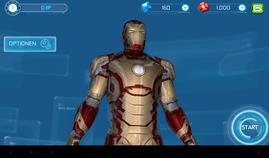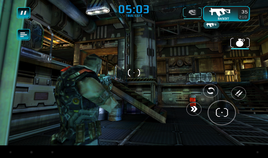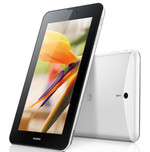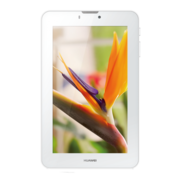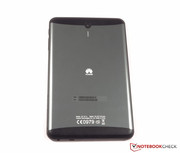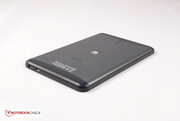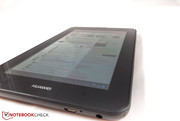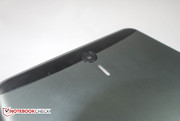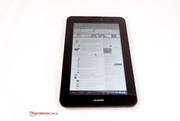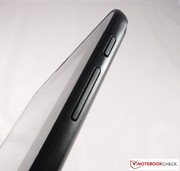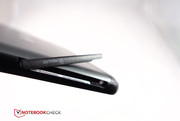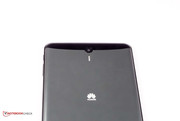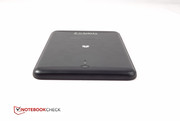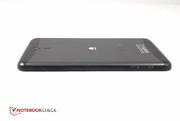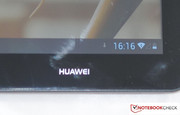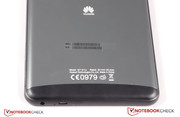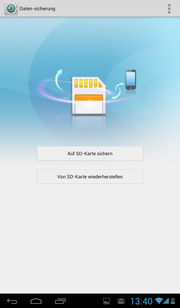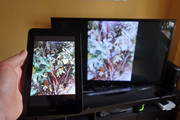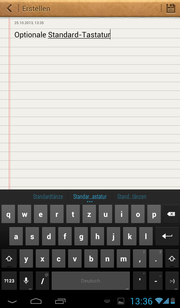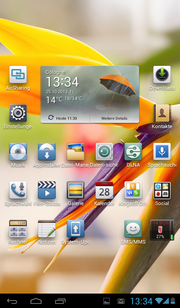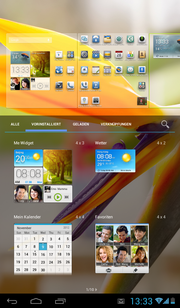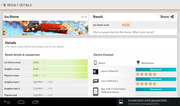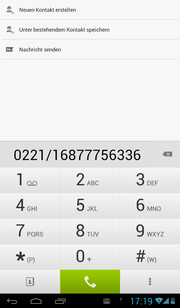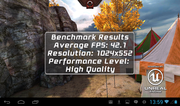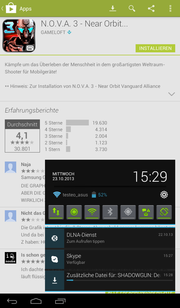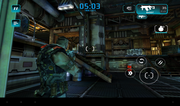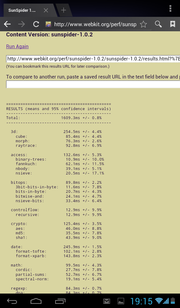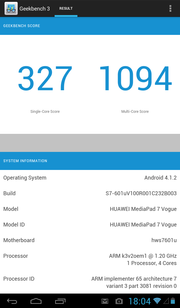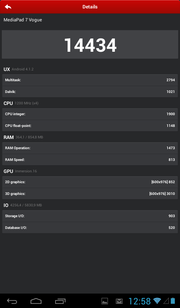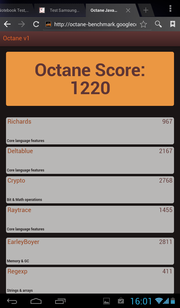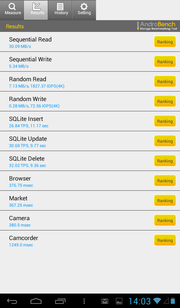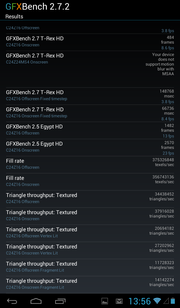Review Huawei MediaPad 7 Vogue Tablet
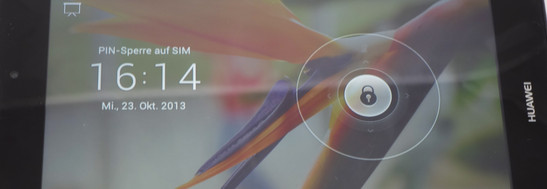
For the original German review, see here.
At a time when even giant cell phones like the Samsung Galaxy Mega or the Sony Xperia Z Ultra can find buyers, it is no longer as far-fetched to hold a tablet up to your ear as it seemed when the first Samsung Galaxy Tab appeared. But to distinguish itself in the smartphone crowd, the Huawei must above all measure itself against the Asus FonePad and the Samsung Galaxy Tab 3 7.0. As is to be expected from its telephone capability, the fact sheet of this newcomer from China offers plain, unexciting specs. The display has a resolution of only 1024x600 pixels (just like the Samsung tablet). The MediaPad 7 Vogue is powered by an in-house K3V2-SoC, whose four cores run at 1.2 GHz; 1 GB of RAM is on board. The meager 8 GB hard drive can easily be expanded by a MicroSD card. Our tests explore how the 250-Euro (~$340) tablet runs in practice.
The case of the MediaPad 7 Vogue makes a generally orderly impression. At a weight of 335 grams (~12 ounces), it is not necessarily the lightest tablet in its class, but the chassis feels stable and lies sturdily in one's hand. It takes strong pressure to cause the case to bow at all, but a distinct, audible creak might bother users with sensitive ears. While the front side, apart from the speakers in the middle, consists completely of glass, Huawei uses a combination of aluminum and plastic for the rest of the case.
The connections between the individual pieces cannot be easily differentiated, and visible gaps between the adjacent parts are not to be seen, so that the workmanship of the MediaPad 7 Vogue can be described as successful.
There is not much to find fault with in the design either. The modest color combination of black and dark gray as well as silver and white has an elegant, timeless effect. The speakers and main camera are placed in the upper middle of the underside and complement the MediaPad's look well. With a thickness of 9.5 mm (~0.4 inches), the Huawei-Tablet is not exactly slim. Nevertheless, in combination with the rounded edges and its medium weight, the MediaPad's feel is still fair. Of course, the MediaPad 7 Vogue cannot keep pace with upscale competitors like the iPad Mini; in comparison with the just-as-expensive Nexus 7 (2013), its weight and thickness detract from its appeal.
To be brief: The new Huawei is definitely not a wonder when it comes to features. The tablet's packaging includes just a power cord and the appropriate micro-USB cable. Huawei forgoes an accompanying headset -- in view of the telephone function of the Vogue, a missed opportunity.
Headphone and micro-USB jacks are located next to each other on the right underside of the tablet. The USB port is OTG-compatible, so that the Vogue can make use of external devices like the DVB-T adaptor or (with the help of a USB-to-OTG cable) hard drives and input devices. With a Unified receiver, we were able to connect a wireless Logitech mouse to the tablet, as well as a USB stick, which can be accessed by the preinstalled data browser.
However, the Vogue's USB-Port is not MHL-compatible. Support for wireless display technology and MicroHDMI access are also missing. Of the 8 GB internal hard drive, only 5.7 GB is available for apps and media, with the system occupying the rest. However, thanks to the SD card reader, the storage problem is easy to work around. The hard drive can be expanded up to 32 GB, which is a great help to the excellent video player (see below).
Software
In factory condition, the MediaPad 7 Vogue runs Android-Version 4.1.2, which is currently over a year old; an update to a new version is not on the radar. As with all Androids from the Huawei factory, the tablet surface is also covered by Huawei's EmotionUI in Version 1.5. Its most obvious alteration is to be found in the home screen, which - comparably with iOS - houses all installed apps, rather than packing them into an extra menu. This may accommodate newcomers to Android, but it does require a bit of folder micromanagement or the installation of an alternate launcher. While most Google applications come preinstalled, Huawei holds back from offering its own giveaways - anyone who has had to rummage through the app-mountain on Samsung or Sony smartphone will know to value this. Among other things, a data manager and a multiple installation tool are among the applications. One nice extra is the opportunity to change the surface with prepackaged themes, which is now possible through the design app.
Communication & GPS
As is customary, the MediaPad 7 Vogue transmits using the WLAN standards 802.11 b, g and n, though only in the 2.4 GHz frequency band. Our tests prove that the tablet offers good service in combination with an Asus AC66U-Router. Even separated from the router by two walls, the Tablet had no problems with the streaming of HD videos. Bluetooth allows communication with other devices, though unfortunately the tablet does not allow the BT 4.0 configuration, which uses less energy; only Bluetooth 3.0 is supported. Users of the MediaPad 7 Vogue must also give up the opportunity to connect with other devices via NFC.
If the MediaPad is upgraded to a telephone using a SIM card, users may conduct conversations just as they would on a smartphone. We found no reason to criticize the service quality when connected to Vodafone or O2 networks. Users who do not necessarily want to hold a 7-inch tablet to their ears can make use of either the speakerphone function or a Bluetooth or cable headset. The latter is worth suggesting, since the MediaPad Vogue's speakers are not exactly the loudest; our conversation partner consistently reported a suboptimal sound quality from the built-in microphone.
As expected, with mobile data service, Huawei declines to support modern LTE networks, so the Vogue downloads data with a decent rate of up to 42 Mbit/s via HSDPA. This is definitely noteworthy, as Huawei's top in-house smartphone, the Ascend P6, has a stream rate of only 21 Mbit/s.
The GPS module performs its service satisfactorily. In our test, it took the MediaPad 7 Vogue between 15 and 20 seconds to locate a GSP fix. This is not overwhelmingly fast, but it suffices for a quick orientation via Google Maps. As far as accuracy, though, the GPS does not exactly strain itself. On our test bicycle route, the Vogue's outlined route promised us many more cross-country shortcuts than we actually pedaled.
Cameras & Multimedia
Yes, you can take photos with the MediaPad 7 Vogue. No, you should not try it. The 3.2-megapixel main camera takes grainy pictures with false colors even in good light conditions. To be fair, it must be said that most tablet cameras are a far cry from their smartphone counterparts. If all you need to do is quickly snap a photo as a memento for your Google Drive, the Huawei tablet fulfills its function. The same goes for the front camera, which offers an even lower resolution (at 0.3 megapixels) but still suffices for Skype, Hangouts, and the like.
The preinstalled media player makes a far better impression. From SD DivX to 1080p MKV files, the MediaPad 7 Vogue smoothly played everything that we loaded on an SD card. Thanks to support for DLNA, the tablet fetches media from the network when necessary or plays it back using compatible players - here Huawei has done very good work indeed.
Input Devices
The 7-inch touch screen of our test product reacts to all inputs without noticeable delay and registers all ten fingers exactly where we place them - here there is absolutely nothing to complain about. The volume controls and the on and off switches on the right side of the case are also easily accessible and offer a comfortable pressure point.
Huawei delivers average fare with its display keyboard, and we had to activate the (adaptive) predictive typing in the input settings. Users can type text fairly comfortably, but they have to forgo extras like configurable key sizes or undoing keystrokes by swiping. This is still the case, if users switch to the standard Android keyboard, since swipe capability is only available in Android 4.2.
With its resolution of 1024x600 pixels, the 7-inch IPS display has an outmoded effect on paper, which comes through in practice. The scant pixel density of 170 ppi results in a fairly ragged text display, which makes it uncomfortable to read long blocks of text. Even in the low-budget segment, a resolution of 1280x800 pixels is basically a requirement (since, at the latest, 2012's Nexus 7), whereas the Vogue can really only compete with the minimal features of the original Kindle Fires or various other cheap tablets.
| |||||||||||||||||||||||||
Brightness Distribution: 92 %
Center on Battery: 357 cd/m²
Contrast: 793:1 (Black: 0.45 cd/m²)
ΔE Color 6.88 | 0.5-29.43 Ø5
ΔE Greyscale 6.71 | 0.57-98 Ø5.3
Gamma: 2.67
As far as color fidelity goes, it becomes obvious not just in practice, but also in a test with the CalMAN Color Checker that the display suffers from a distinct blue tint. Apart from that, the DeltaE variance sits at a value of 6.88, or 6.71 in grayscale test - not good, but acceptable for this price class. The high color temperature of 7.537k on average exacerbates the blue tint, which asserts itself in particular with white pictures.
In terms of viewing angle stability, Huawei offers no high points with the Vogue. Even a slight tipping causes a marked reduction in contrast and color fidelity. In fairness, it must be said that the display does not look quite as bad in practice as our measurements would suggest. With colorful contents (as in games and films), the MediaPad 7 Vogue makes a thoroughly acceptable impression.
The maximum brightness, with an average of 357 cd/m², is at a passable level. It is definitely a far cry from the top-of-the-line Nexus 7 (2013), but it suffices to recognize the screen's contents in most light conditions. Direct sunlight is simply too much for the Huawei tablet, but the Vogue shares this fate with most of its colleagues.
In contrast to most of the competition, Huawei does not install a SoC from Nvidia or Qualcomm, but instead uses the K3V2 of its own development. The four Cortex A9 cores of the MediaPad 7 Vogue each clock in at 1.2 GHz, thereby lying 0.3 GHz behind the Smartphone Ascend P6, in which the same SoC solution putters along. In our benchmarks, this processor architecture, manufactured at 40 nm-scale production, limps behind the current Cortex A15 systems, like Nvidia’s Tegra 4 or Samsung's Exynos 5, and hovers generally around the performance levels of last year's tablets. In Geekbench 3's Multicore test, the Huawei machine finishes just below the Asus EeePad Transformer Prime TF201 with the aging Tegra 3-SoC; even Nexus 4 with its mid-class Snapdragon chipset outpaces the MediaPad in several tests.
The similarities to Tegra 3 become apparent in other tests, such as the Multicore Benchmark from Linpack, which places the K3V2 on a similar level to (for example the Acers Iconia Tab A211 or the third-generation iPad). The generally meager benchmark results are apparent not just in theory, but also in practice: in switching between apps or in swiping over the home screen, minor stutters are consistently noticeable. Even the switch from portrait to landscape format and back is regularly plagued by brief delays.
| Geekbench 3 | |
| 32 Bit Single-Core Score (sort by value) | |
| Huawei MediaPad 7 Vogue | |
| Asus Fonepad ME372CG | |
| 32 Bit Multi-Core Score (sort by value) | |
| Huawei MediaPad 7 Vogue | |
| Asus Fonepad ME372CG | |
| AnTuTu v4 - Total Score (sort by value) | |
| Huawei MediaPad 7 Vogue | |
| Asus Fonepad ME372CG | |
In browser tests, the MediaPad 7 Vogue also places somewhere in the middling no-man's-land of the testing field. In Peacekeeper benchmarks, the Samsung Galaxy Tab 3 8.0 achieves a total of 237 more points, and even in JavaScript tests like Google's Octane V1 or Mozilla's Kraken, the MediaPad 7 Vogue can offer only a few high points. It must be said in fairness that the preinstalled browser (based on Google's AOSP browser) does not look at all bad in actual use. Even complex sites with many graphical elements load without problems and can be smoothly scrolled and zoomed through.
| Peacekeeper - --- (sort by value) | |
| Huawei MediaPad 7 Vogue | |
| Asus Fonepad ME372CG | |
| Google Nexus 7 2013 | |
| Google Nexus 7 | |
| Samsung Galaxy Tab 3 7.0 inch | |
| Samsung Galaxy Tab 3 8.0 SM-T310 | |
| Octane V1 - Total Score (sort by value) | |
| Huawei MediaPad 7 Vogue | |
| Asus Fonepad ME372CG | |
| Google Nexus 7 2013 | |
| Google Nexus 7 | |
| Samsung Galaxy Tab 3 7.0 inch | |
| Samsung Galaxy Tab 3 8.0 SM-T310 | |
| Mozilla Kraken 1.1 - Total (sort by value) | |
| Huawei MediaPad 7 Vogue | |
| Asus Fonepad ME372CG | |
| Sunspider - 1.0 Total Score (sort by value) | |
| Huawei MediaPad 7 Vogue | |
| Asus Fonepad ME372CG | |
| Google Nexus 7 2013 | |
| Samsung Galaxy Tab 3 7.0 inch | |
| Samsung Galaxy Tab 3 8.0 SM-T310 | |
* ... smaller is better
Storage Devices
We checked, using the Flash benchmark AndroBench 3, how well the tablet's 8 GB flash memory runs -- and unearthed a vicious performance bottleneck. With just over 30 MB/s on sequential reading and 5.34 MB/s on writing, this tablet places even blow the first Nexus 7, whose weak Flash performance counted as its greatest weak point. The consequences are apps that are slow to start and long load times, which clouds the general impression of the tablet's performance.
Gaming Performance
In terms of gaming performance, there are not any big surprises: The integrated immersion GPU with its 16 cores supports, at maximum, the OpenGL 2.0 API and thereby limps behind the current competition. In 3DMark 2013's Ice Storm Physics test, the current Nexus 7 achieved double the score of the Huawei candidates, and even the 2012 Nexus left the MediaPad 7 Vogue in the dust. The ambitious 3D titles from PlayStore accordingly make the Huawei offshoots sweat: ShadowGun Deadzone becomes an orgy of jerks and stutters, and other titles like Iron Man 3 do not even start up. The preinstalled jet-ski racing game Riptide GP plays nearly without jerks, proving that the MediaPad 7 Vogue is not completely unsuitable for 3D games. Casual games like Angry Birds and its ilk are also no problem, so that a little game from time to time is certainly possible.
Temperature
In issues of temperature, the tablet proves itself pleasantly unobtrusive. In its idle state, the measured temperatures lie just a few degrees above room temperature. Even under load, the MediaPad 7 Vogue becomes warm only in the middle. We reached the maximum temperature of 40 degrees Celsius (104 Fahrenheit) in one place after an hour of our stress test (which is not necessarily representative of daily use), and even then the rest of tablet kept its cool, with temperatures between 29 and 34 degrees Celsius (84.2 and 93.2 Fahrenheit). While playing 3D games, we can sympathize with these measurements: the increased warmth stays at a palpable but still fairly minimal level and does not cause any problems during use.
(±) The maximum temperature on the upper side is 40 °C / 104 F, compared to the average of 33.8 °C / 93 F, ranging from 20.7 to 53.2 °C for the class Tablet.
(+) The bottom heats up to a maximum of 35.1 °C / 95 F, compared to the average of 33.3 °C / 92 F
(+) In idle usage, the average temperature for the upper side is 27.8 °C / 82 F, compared to the device average of 30 °C / 86 F.
Speakers
As we mentioned earlier while discussing telephone usage, the mono speakers of the MediaPad 7 Vogue do not boast the best sound quality. They are loud enough during media playback, but they tend (at about 70 percent of its volume) to produce strong jangling noises and distorted voices. For media playback, we definitely recommend connecting external speakers or headphones.
Energy Management
Power Consumption
At 4100 mAh, the solidly built battery of MediaPad 7 Vogue is certainly well proportioned, which led us to hope for a good battery life. In practice, the tablet actually achieved a very passable time of 6 hours and 48 minutes in the practically relevant WLAN test before it shut down. During this test, we set the display brightness to 150 cd/ m² and used an automatic script to continuously load a succession of web sites. Here the MediaPad 7 Vogue shows a similar duration to the top-of-the-line 7-inch model, the Nexus 7 2013. For fairness's sake, it must be said that Google's tablet pushes three times as many pixels over the screen in that time.
| Off / Standby | |
| Idle | |
| Load |
|
Under load, it does not look so good. In a stress test (the Stability Test 2.5) under full brightness and activated WLAN, the Huawei tablet shuts down after 2 hours and 35 minutes. Under a minimal test, during which an e-book site was shown under the lowest brightness and inactive WLAN, shutdown hit after 15 hours and 32 minutes - an average value.
Throughout our tests, it was difficult to shake the feeling that the MediaPad 7 Vogue is simply a year too late to the party. Even in 2012, the display and overall performance would have been below average at best for a 7-inch model, but as a cheap surf-tablet with a 3G modem and telephone capability, it would at least have been competitive at that time.
But for the home stretch of 2013, this reasonably unique selling point isn't worth as much in view of the competition posed by the Asus FonePad or the Samsung Galaxy Tab 3 7.0, which offer better displays, more storage space, or simply superior performance. These aspects are also reflected in our overall score, in which the MediaPad 7 Vogue's impression became more and more negative in our sight. In particular, the pixellated display is (despite usable color reflection) not competitive.
Users who can go without mobile data connection find in the current Nexus 7 or even the Kindle Fire HDX 7 devices that are similar in every department at a similar price. Also, 7-inch models with HSDPA service under the 250-Euro (~$339) price boundary are no longer such a rare sight. Nevertheless, for those narrow cases when the choice to buy really revolves around the ability to make phone calls on the tablet, it would make sense to pick the Huawei MediaPad 7 Vogue.
While it stands more or less on a level with the Samsung model of the same size, in our sight the Asus FonePad performs better in head-to-head competition. In any case, the biggest plus for Huawei here is the Cortex A9-SoC, which appears slightly better in comparison with its Intel counterpart in terms of performance and app compatibility. Whether the inferior display offsets this factor is, in the end, up to the customer to decide.


 Deutsch
Deutsch English
English Español
Español Français
Français Italiano
Italiano Nederlands
Nederlands Polski
Polski Português
Português Русский
Русский Türkçe
Türkçe Svenska
Svenska Chinese
Chinese Magyar
Magyar
